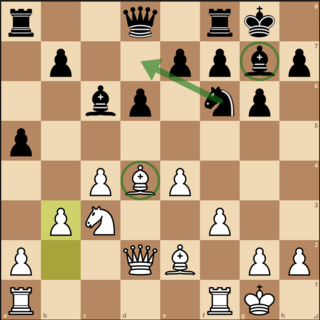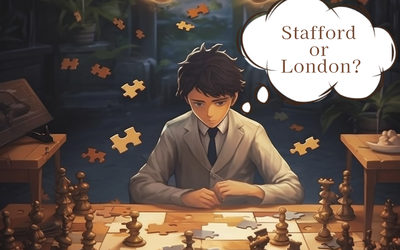
How to Evaluate?
How the Evaluation Really Works?Have you ever wondered how GMs can evaluate positions in just a matter of seconds?
I am often asked by my students: "How is that even possible?"
Let's discover the methods used by GMs and how you can apply them as well!
First, let's establish that there are two ways to evaluate a position: Analysis and Intuition. Most often, you can hear that in the beginning, you need to analyze all elements of position (safety of the king, material, pawn structure, active/passive pieces). Then you combine everything and get an evaluation. On paper, everything seems great. However, can it be implemented during the game?
I don't think so!
During the game, one has to evaluate a huge number of positions, including those on the board and those that come to mind when considering different alternatives.
If you consistently rely on the commonly recommended evaluation method, you may find yourself running out of time even when playing classical time control. Using an analytical approach can be reasonable to evaluate 1-2 positions when you feel that it is such an important decision, that the whole game depends on it.
What to do then? The answer is: rely on your intuition!
Easier said than done... but don't get disappointed, I will show you how to train.
What is Intuitive Evaluation?
Let's discuss the nature of intuitive evaluation, in other words, relying on your experience.
For example, if you play Italian, you may know that you are not supposed to give up the bishop c4 for the knight c6 by allowing Na5.

Or if you play Maroczy structure, exchanging the bishop on g7 for the bishop d4 is fine for black if the pawn stays on f3.

You can get this information from a coach, book, engine (when you analyze your games), or the training that I suggest later. Notice that many decisions are typical for certain structures. And over time, if you learn them, your evaluation becomes more and more precise. You start getting the following thoughts: "Usually 'this' move/exchange/maneuver is good for white/black" or "Wait, the opponent is not supposed to play it, can I punish him?" or "Even though my pawns are doubled, typically it is fine in this opening line" and so on.
In most cases, if you are aware of what is "supposed to happen," you only need to determine if your current position is an exception or not. This way, you can quickly focus on things that seem unusual.
Basically, these typical ideas work as Lighthouses that illuminate your way through different circumstances.
Training
Now, let's talk about possible ways you can absorb typical ideas and train evaluation. These include seeking the guidance of a coach, reading books, watching videos, and analyzing your games with an engine.
Getting a coach or reading books can be very helpful, but they can also be quite expensive. Some methods, like watching videos, have random quality, while others, like playing and analyzing, require too much time. Fortunately, there is a free and direct way to train evaluation without spending too much time per session.
You have to do the following steps:
- Go to 'Watch' on lichess.
- Then 'Broadcasts'
- Then select any tournament that is ongoing (live)
- Now press on any game that is live
- Give yourself around 30 seconds to evaluate the position (you can give a number, like +0.7)
- Press "turn on engine"

7. Compare your evaluation with that of an engine. If the difference is more than 0.5 - you are incorrect, if less than 0.5 - you are correct. Approach any evaluation bigger than +2(winning) as the same ones. So, if you give +2, but the engine says +5 - your answer is correct.
The idea is that with this method you can evaluate a large number of positions. Through this quantity, you notice similarities and begin recognizing many strategical patterns.
That was the first part of the training.
Confusing Extra Step
Why do we need another extra step?
If you practice this training consistently, you will notice a significant improvement in the accuracy of your predictions. However, it is important to note that during a game, you may encounter an issue:
- You evaluate the position correctly, that it is better for you.
- You make several solid moves
- You again evaluate correctly the position, that it is worse for you. But you didn't even blunder!
So, what on earth just happened?
The same exact position can be worse short-term(the king is under attack, lack of
development, etc) and better long-term (structure, extra material, etc). This means that your position could be much better short-term (more active pieces; so, you were supposed to start the attack), but worse long-term (suspicious structure). Thus, after missing the momentum, your opponent consolidated, you no longer have active opportunities and have to suffer a positional nightmare.
That's why we need to train that as well. Here is our final step:
8. Ask yourself the following question: does your number reflect the long-term evaluation or the short-term one?
Checking your answer with an engine is quite simple:
- If you say that one side is much better long-term (structure, extra material) then just try different solid (half-waiting) moves. Is the number pretty much the same? Good, your evaluation was correct. If it drops, then you are wrong.
- If you say that one side is better short term (attack, initiative) then look for forced moves that attack/sacrifice something and check what the engine thinks. If one of your moves is correct, Good, your evaluation is correct. If all forced moves fail, then you are likely wrong.
If we combine everything together we get the following process:
Look at any position for 10-30 seconds and guess the number (or say that it is slightly better, much better, etc). Then ask yourself if this is a long-term evaluation or a short-term one (In other words, is it going to decrease or increase if you make several solid moves?). Basically, you rely on your intuition to get a "fact" and then attempt to translate it into more rational conclusions that can be used to find candidate moves.
Warning
- Notice that sometimes the position can be both: worse long-term and short-term or better long-term and short-term. In that case, the decision is mostly based on a style of a player.
Also, remember: evaluation shouldn't substitute calculation. If the move is forced - you still need to calculate. Thus, if you decide that your position is worse long-term and you have only one aggressive move, that doesn't mean that you have enough information to play it. Most aggressive moves are forced ones (have a threat), and forced moves require calculation. Basically, you can be worse long-term and the only aggressive move that you have just lost on the spot. In that case, you would rather prefer defending passively.

Inarkiev - Matlakov 2021
For example, in this case, white is worse long-term because they can neither change the structure in their favor nor improve pieces. However, they have an aggressive move e4 using the x-ray against the g7 King.
Can white play e4 just because they are worse long-term?
Absolutely, not. Playing e4 leads to a forced position. Thus, requires calculation.
If you calculate the line you get: 1.e4 fxe4 2.fxe4 Nxe4! 3.Bxe4 Rae8 and black wins a pawn due to the pin and gets a decisive advantage. Instead of e4, any solid move would be better. Let's say white can play h3 Re1 and then hold. It is not easy to break through for black.
Relying solely on evaluation when making decisions can be risky, especially when there are forced moves and calculation is required. Nonetheless, evaluation is a valuable tool for understanding the game's direction. Therefore, dedicating significant time to improving your evaluation skills is a wise decision.
I hope your Evaluation is going to become as precise as a surgeon's scalpel.
GM Gordievsky Dmitry, 'Gordima'
Follow me for more content: https://taplink.cc/gordima
More blog posts by Gordima

Hikaru's Blitz Repertoire Part II
Your support made the second part possible!
Hikaru's Blitz Repertoire 2023
Learn to play practical, and tricky openings like Hikaru
Build Your Unique Repertoire
Do you think it's wise to play the same repertoire as your coach or purchase a random course? Here i…
